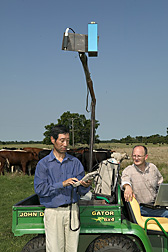This page has been archived and is being provided for reference purposes only. The page is no longer being updated, and therefore, links on the page may be invalid.
Read the magazine story to find out more. |
|
Hand-Held Sensor to Gauge Nutrients in Livestock Forage
By Luis PonsSeptember 8, 2005
Imagine a livestock producer knowing, almost immediately, how much nutrition a calf is getting from the grass it's grazing on--or even how much weight that calf will gain if it keeps eating that same grass.
That may be possible one day, thanks to recent developments with spectral reflectance technology at the Agricultural Research Service's (ARS) Grazinglands Research Laboratory in El Reno, Okla.
The lab recently established a cooperative research and development agreement with two private firms based in Oklahoma for designing, manufacturing and marketing a small, low-cost, hand-held optical remote sensor that can calculate, store and display data on forage's nutrient quality.
Under the agreement, the instrument will be developed by Durant Design and Development in Durant, and will be manufactured and marketed by TerraVerde Technologies in Stillwater.
According to ARS soil scientist Patrick Starks, the nutritional value of live, standing forages in pastures is essential knowledge for livestock producers. It allows them to make informed management decisions about stocking rates, beginning and ending dates for grazing, and the need for supplements.
Previously, Starks and ARS collaborators including El Reno animal scientist William Phillips and Samuel Coleman at the Subtropical Agricultural Research Station in Brooksville, Fla., showed that spectral reflectance data can almost immediately show quality of forage grasses. The method's accuracy is comparable to much slower conventional lab analysis.
The El Reno research also led to an interesting side study in which ARS animal scientist Michael Brown and Redlands Community College undergraduate student Amina Phillips found that spectral technology can help predict weight gains and growth of foraging animals.
Read more about this research in the September 2005 issue of Agricultural Research magazine.
ARS is the U.S. Department of Agriculture's chief in-house scientific research agency.

